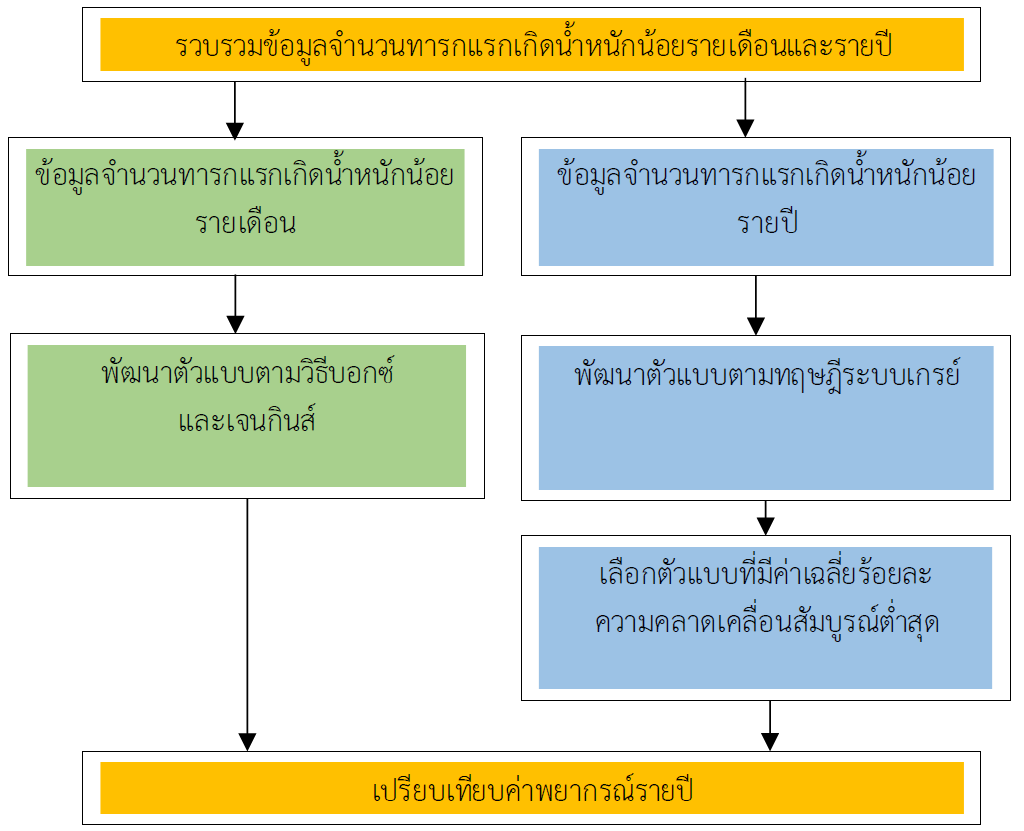การพยากรณ์จำนวนทารกน้ำหนักแรกเกิดน้อยในจังหวัดชุมพร
คำสำคัญ:
การพยากรณ์, ทารกน้ำหนักแรกเกิดน้อย , ทฤษฎีระบบเกรย์ , วิธีบอกซ์และเจนกินส์บทคัดย่อ
การวิจัยเชิงปริมาณพยากรณ์นี้มีวัตถุประสงค์เพื่อศึกษาการพยากรณ์จำนวนทารกน้ำหนักแรกเกิดน้อยในจังหวัดชุมพรปีงบประมาณ 2567 โดยรวบรวมข้อมูลจากกระทรวงสาธารณสุข กลุ่มรายงานมาตรฐาน อนามัยแม่และเด็ก ร้อยละของทารกน้ำหนักแรกเกิดน้อยกว่า 2,500 กรัม เขตสุขภาพที่ 11 เป็นข้อมูลรายเดือนปีงบประมาณ 2556 - 2566 และ ปีงบประมาณ 2567 มีข้อมูลเดือนตุลาคม 2566 - เมษายน 2567 วิเคราะห์ข้อมูลด้วยวิธีที่สอดคล้องกับจำนวนข้อมูลโดยข้อมูลรายเดือนใช้วิธีบอกซ์และเจนกินส์ และข้อมูลรายปีใช้ทฤษฎีระบบเกรย์ ตรวจสอบความแม่นยำของตัวแบบด้วยค่าเฉลี่ยร้อยละความผิดพลาดสัมบูรณ์ ประมวลผลด้วยโปรแกรม R และโปรแกรม MICROSOFT Excel ตามลำดับ ผลการวิจัยพบว่า
เมื่อใช้ข้อมูลรายเดือนปีงบประมาณ 2556 – 2566 พยากรณ์จำนวนทารกแรกเกิดน้ำหนักน้อยปีงบประมาณ 2567 ได้ตัวแบบ ARIMA(0,1,1)(2,0,0)12 มีค่าพยากรณ์อยู่ระหว่าง 12 - 15 รายต่อดือน ค่าเฉลี่ย 13 รายต่อเดือน หรือ 156 รายต่อปี เมื่อเทียบกับตัวแบบ GM(1,1)EPC ที่มีค่าเฉลี่ยร้อยละความผิดพลาดสัมบูรณ์ต่ำสุด 5.14 พยากรณ์จำนวนทารกแรกเกิดน้ำหนักน้อย ปีงบประมาณ 2567 จำนวน 148 รายต่อปี ตามแนวโน้มของจำนวนทารกแรกเกิดน้ำหนักน้อยรายปีที่ลดลง ต่ำกว่าวิธีบอกซ์และเจนกินส์ 8 ราย หรือร้อยละ 5.13
กล่าวได้ว่าทั้งสองวิธีให้ค่าพยากรณ์ใกล้เคียงกันหน่วยงานสาธารณสุขในพื้นที่สามารถนำผลการพยากรณ์ไปใช้ในการจัดทำงบประมาณเพื่อการรณณรงค์ป้องกันและส่งเสริมสุขภาพของมารดาต่อไป
เอกสารอ้างอิง
Abu Hasan, N.I., Abdul Aziz, A., Ganggayah, M., Jamal, N.F., & Abdul Ghafar, N.M. (2022). Projection of infant mortality rate in malaysia using R. Jurnal Sains Kesihatan Malaysia, 20(1), 23-36. doi: 10.17576/JSKM-2022-2001-03.
Agarwal, M., Tripathi, P.K., & Pareek, S. (2021). Forecasting infant mortality rate of india using ARIMA model: A comparison of bayesian and classical approaches. Statistics and Applications, 19(2), 101 –114.
Andrés, D. (2023). Machine Learning Pills: Error Metrics for Time Series Forecasting. Retrieved May 5, 2024 from https://mlpills.dev/time-series/error-metrics-for-time-series-forecasting/
Box, G.E.P., & Jenkins, G.M. (1976). Time Series Analysis, forecasting and Control. San Francisco: Holden-Day.
Çetin, T., & Çilengiroglo, Ö.V. (2023). New approaches in time series analysis: Health data application. International Journal of New Horizons in the Sciences, 1(1), 1-11.
Chakreyavanich, R. (2020). Factors related to low birth weight in health region 5. Journal of Public Health Nursing, 34(3), 1-17. (in Thai)
Chumphon Provincial Public Health Office. (2024). Medical and Health Data Warehouse System, Chumphon Province. Retrieved November 15, 2024 from https://cpn.hdc.moph.go.th/hdc/main/index_pk.php (in Thai)
Deng, J. (1982). Grey control system. Journal of Huazhong University of Science and Technology, 1, 9–18.
Hales, D. (2010). An Introduction to Triangulation. Switzerland: UNAIDS.
Hao, J., Peng, L., Cheng, P., Li, S., Zhang, C., Fu, W., et al. (2022). A time series analysis of ambient air pollution and low birth weight in Xuzhou, China. International Journal of Environmental Health Research. 32(6), 1238–1247.
Harnsomboon, T. (2022). Evaluation of antenatal care, maternal and Infant health,Lang Suan district, Chumporn province. Mahasarakham Hospital Journal. 19(1), 23-33. (in Thai)
Hyndman, R. J., & Athanasopoulos, G. (2018). Forecasting: Principles and Practice, 2nd Edition (Online version last updated on 26 October 2023). Melbourne: OTexts
Hyndman, R. J. & Khandakar, Y. (2008). Automatic time series forecasting: The forecast package for R. Journal of Statistical Software, 27(3), 1-12.
Hyndman, R. J., & Kostenko, A. V. (2007). Minimum sample size requirements for seasonal forecasting models. Foresight, 6, 12-15.
Kotu, V., & Deshpande, B. (2019). Chapter 12 - Time Series Forecasting. In Data Science. (2nd Edition). (pp. 395-445). Massachusetts: Morgan Kaufmann.
Lewis, C.D. (1982). Industrial and Business Forecasting Methods. London: Butterworths.
Lin, Y. H., Chiu, C. C., Lin, Y. J., & Lee P. C. (2013). Rainfall prediction using innovative grey model with the dynamic index. Journal of Marine Science and Technology, 21(1), 63-75. doi:10.61 19/JMST-011-1116-1.
Liu, S. (2021). Grey System Theory and its Application. (9th Ed.). Beijing: Science Press.
Liu, S., & Lin, Y. (2010). Grey System Theory and its Application. Berlin, Heidelberg: Springer.
Lu, M. (2015). Grey System: Theory, Methods, Applications and Challenges. Retrieved November 17, 2024 from https://www.dmu.ac.uk/documents/technology-documents/research-faculties/cci/lu-grey-system-2015.pdf
Mahidol University. (2023). Announcement of Mahidol University Regarding Guidelines for Research Projects that Do Not Qualify as Human Research, 2022. Retrieved May 5, 2024 from https://sp.mahidol.ac.th/th/LAW/policy/2565-MU-Non-Human.pdf (in Thai)
Mahidol University Central Institutional Review Board (MU-CIRB). (2022). Self-Assessment form Whether an Activity is Human Subject Research Which Requires Ethical Approval. Retrieved May 5, 2024 from https://sp.mahidol.ac.th/th/ethics-human/forms/checklist/2022-Human%20Research%20Checklist-researcher.pdf. (in Thai)
Ministry of Public Health. (2024). Standard Reporting Group Maternal and Child Health Percentage of Infants with Birth Weight Less than 2,500 grams, Health Zone 11. Retrieved May 5, 2024 from https://hdcservice.moph.go.th. (in Thai)
Mishra, A. K., Sahanaa, C., & Manikandan, M. (2019). Forecasting Indian infant mortality rate: An application of autoregressive integrated moving average model, Journal of Family Community Med., 26(2), 123-126.
NCSS Statistical Software. (n.d.). Chapter 470 The Box-Jenkins Method. Retrieved November 17, 2024 from https://www.ncss.com/wp-content/themes/ncss/pdf/Procedures/NCSS/The_Box-Jenkins_ Method. pdf
Nwokike, C, Offorha, B. C., Obubu, M., & Uche-Ikonne, O. (2020). ARIMA modelling of neonatal mortality in Abia State of Nigeria. Asian Journal of Probability and Statistics, 6(2), 54-62.
Oseni, B. M., & Igboroodowo, O. J. (2022). Modelling of infant mortality rate in Nigeria using autoregressive moving average and neural network autoregression. Rattanakosin Journal of Science and Technology: RJST, 4(2), 2-9.
Rattanahon, J. & Jayathavaj, V. (2024). Predicting the number of neonatal deaths in Thailand using grey system theory. Journal of Medicine and Public Health, Ubon Ratchathani University, 7(2), 154-163. (in Thai)
Statistical Modeling and Forecasting. (n.d.). 3.3 Regression Models for Counts Data Sets. Retrieved August 11, 2024 from https://timeseriesreasoning.com/.
Talirongan, F. J. B., Talirongan, H., & Orong, M. Y. (2020). Modeling national trends on health in the Philippines using ARIMA. Journal of Health & Medical Informatics, 11(1), 1-6.
Tangsakul, P. (2011). Related factors of low birth weight infant. Journal of Yala Rajabhat University, 6(2), 113-122. (in Thai)
United Nations, Department of Economic and Social Affairs, Population Division. (2024). World Population Prospects: The 2024 Revision, Custom Data Acquired Via Website. Retrieved August 11, 2024 from https://population.un.org/dataportal/data/indicators/22/locations/ 458/start/1990/end/2024/table/pivotbylocation?df=0e3fb2a0-f89f-49c2-bd7a-69de13232f98
World Bank. (n.d.). Outlier Detection and Treatment LECTURE 12. Retrieved May 5, 2024 from https://thedocs.worldbank.org/en/doc/20f02031de132cc3d76b91b5ed8737d0-0050012017/related/ lecture-12-1.pdf
World Health Organization (WHO). (2024). Low Birth weight. Retrieved May 5, 2024 from https://www.who.int/data/nutrition/nlis/info/low-birth-weight
World Health Organization (WHO). (2014). Global Nutrition Targets 2025: Low Birth Weight Policy Brief (WHO/NMH/NHD/14.5). Geneva: World Health Organization.
Xie, N. (2022). A summary of grey forecasting models. Grey Systems: Theory and Application, 12(4), 703–722. doi:10.1108/GS-06-2022-0066

ดาวน์โหลด
เผยแพร่แล้ว
ฉบับ
ประเภทบทความ
สัญญาอนุญาต
ลิขสิทธิ์ (c) 2024 วารสารเครือข่ายวิทยาลัยพยาบาลและการสาธารณสุขภาคใต้

อนุญาตภายใต้เงื่อนไข Creative Commons Attribution-NonCommercial-NoDerivatives 4.0 International License.
1. บทความหรือข้อคิดเห็นใด ๆ ที่ปรากฏในวารสารเครือข่าย วิทยาลัยพยาบาลและการสาธารณสุขภาคใต้ ที่เป็นวรรณกรรมของผู้เขียน บรรณาธิการหรือเครือข่ายวิทยาลัยพยาบาลและวิทยาลัยการสาธารณสุขภาคใต้ ไม่จำเป็นต้องเห็นด้วย
2. บทความที่ได้รับการตีพิมพ์ถือเป็นลิขสิทธิ์ของ วารสารเครือข่ายวิทยาลัยพยาบาลและการสาธารณสุขภาคใต้







